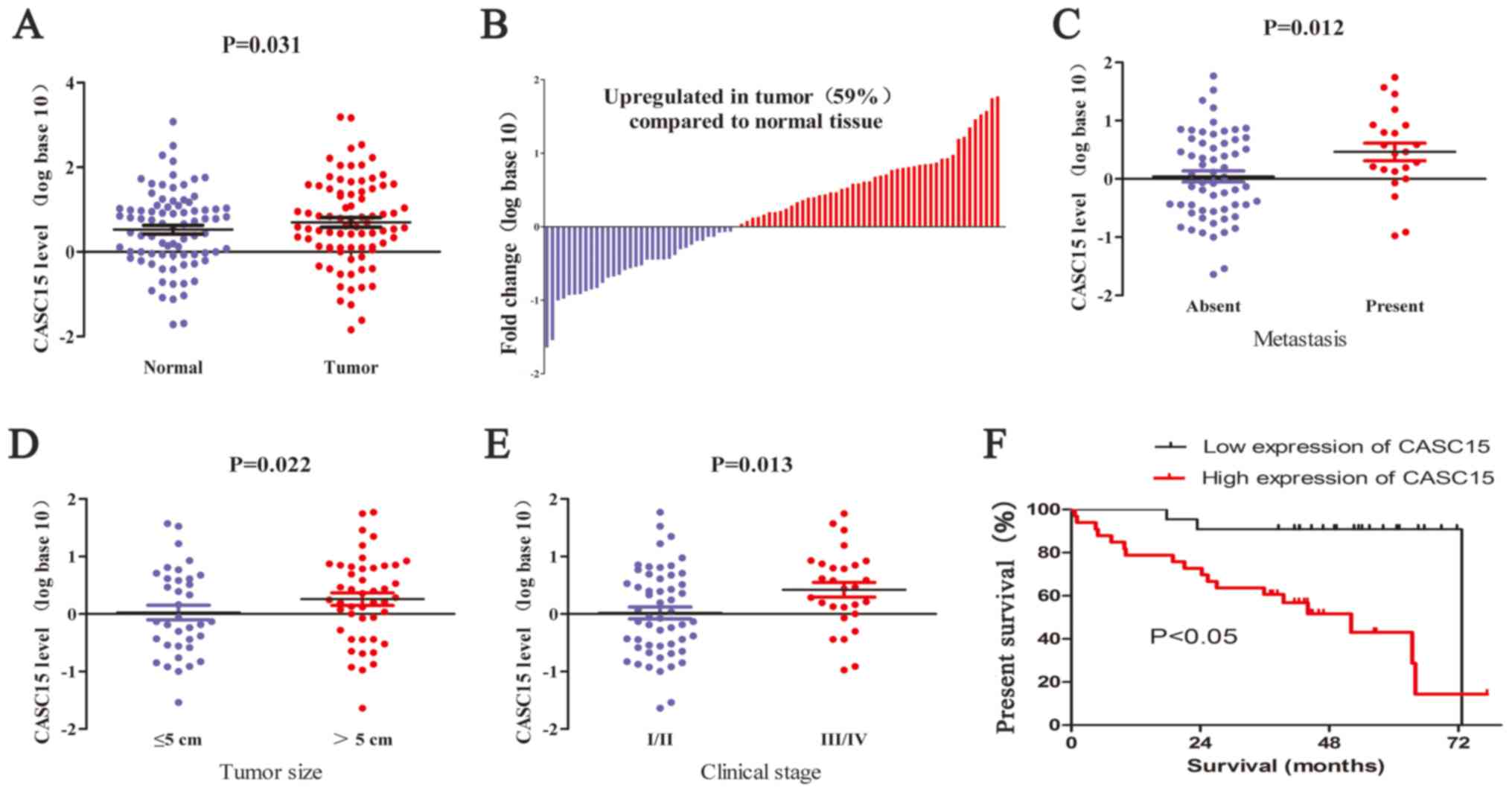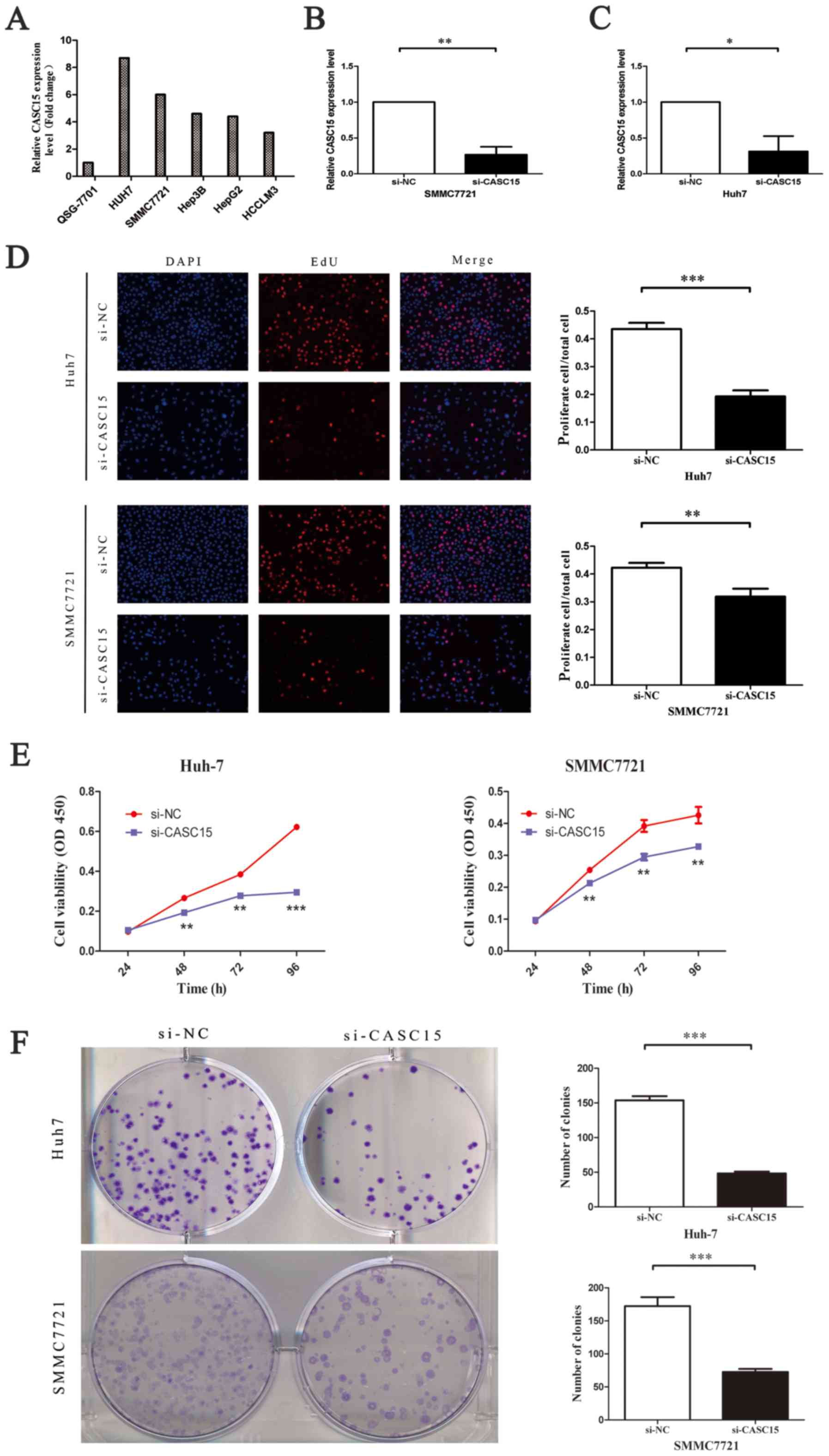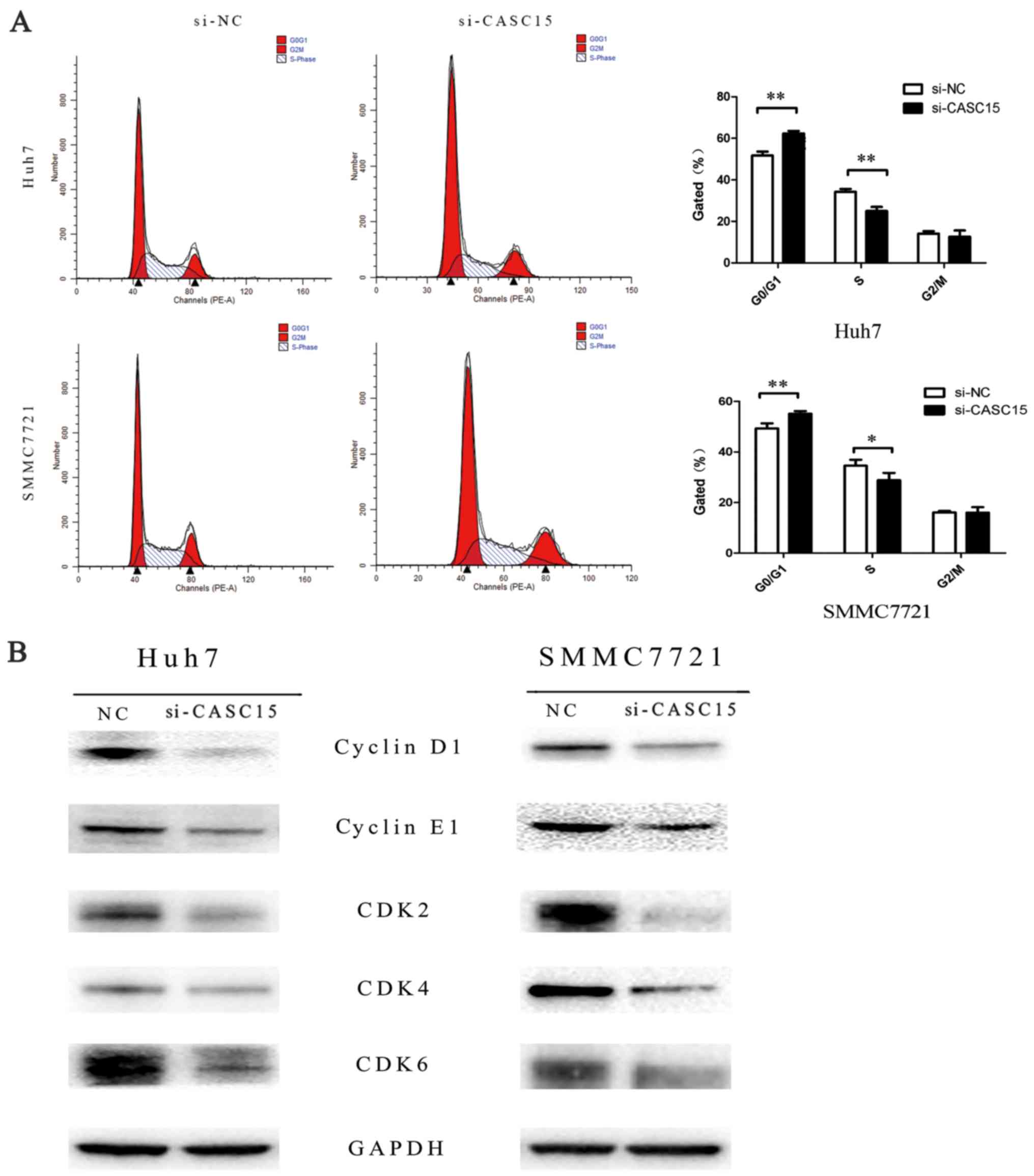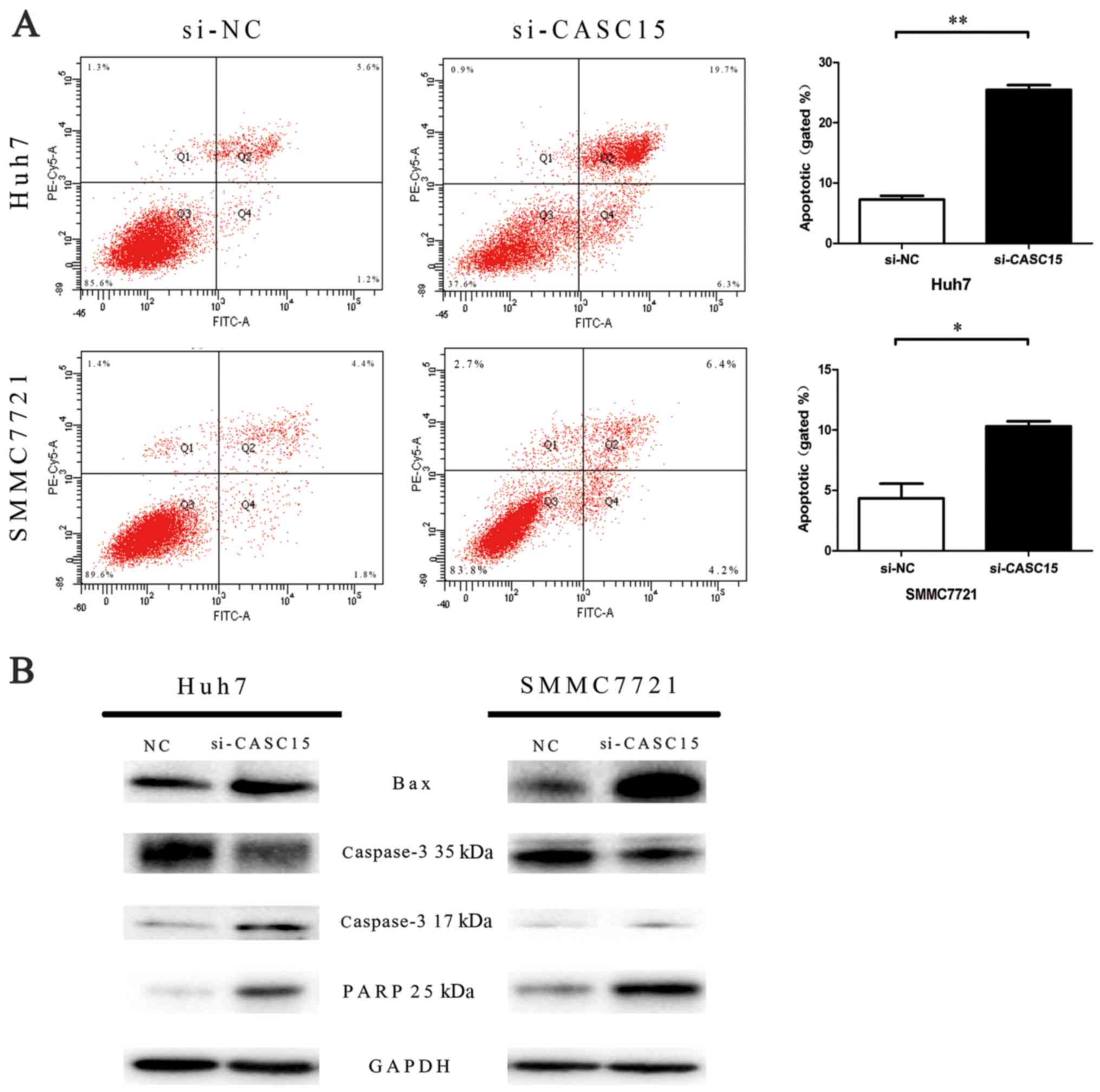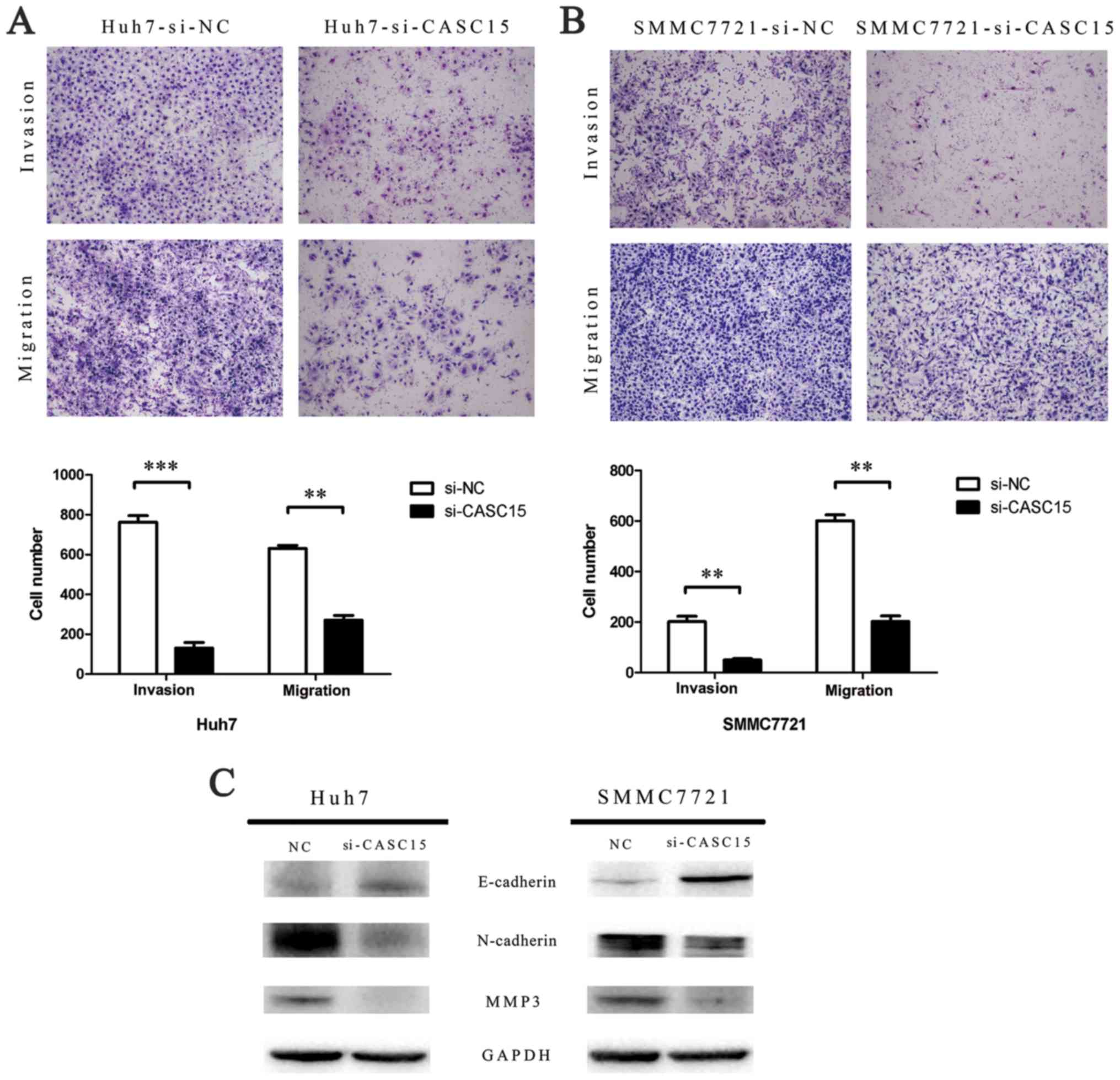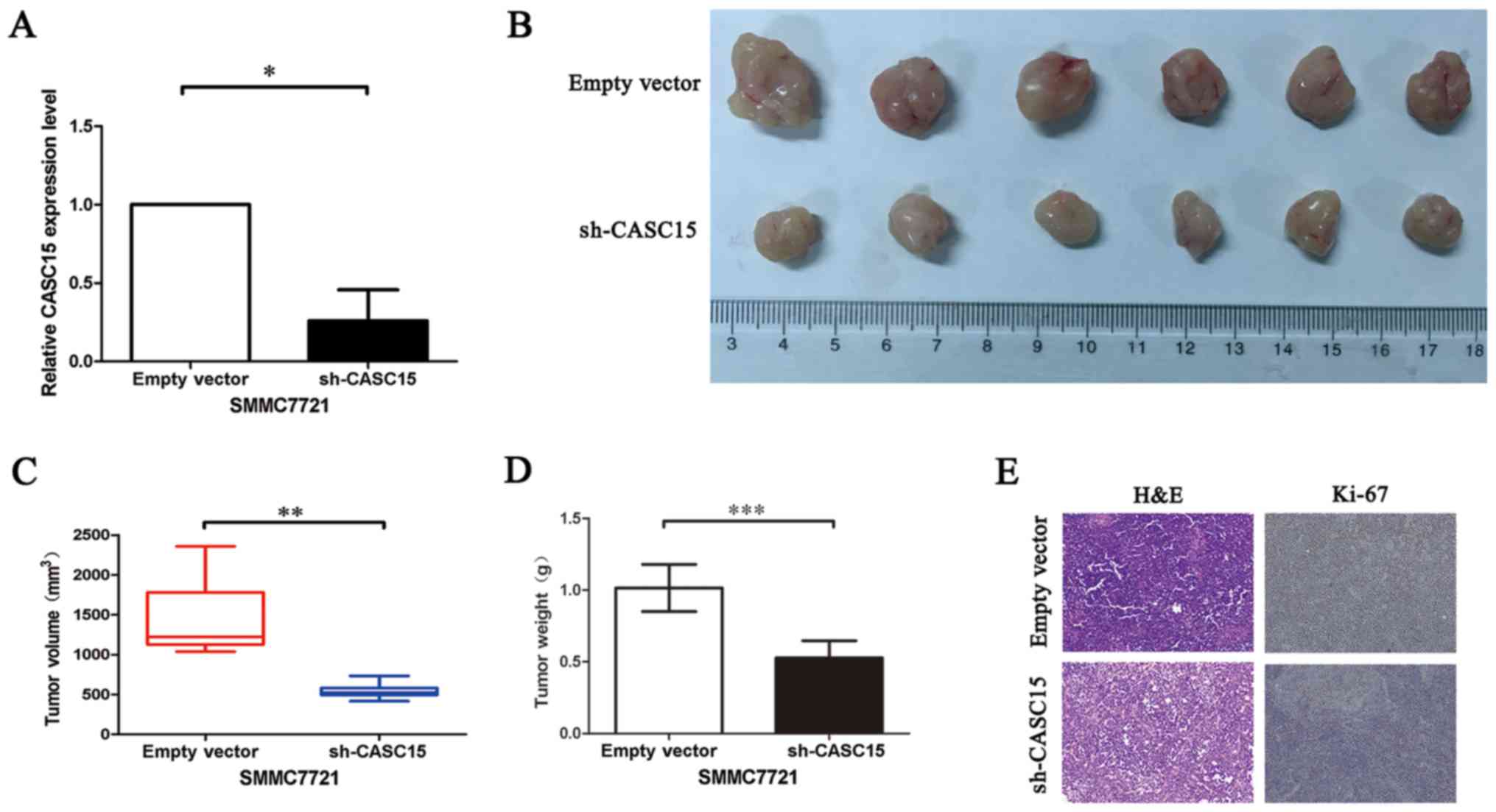Long non-coding RNA CASC15 is upregulated in hepatocellular carcinoma and facilitates hepatocarcinogenesis
- Authors:
- Published online on: October 23, 2017 https://doi.org/10.3892/ijo.2017.4175
- Pages: 1722-1730
-
Copyright: © He et al. This is an open access article distributed under the terms of Creative Commons Attribution License.
Abstract
Introduction
Hepatocellular carcinoma (HCC) is one of the most common malignant tumors in China and worldwide, accounting for one-sixth of all malignant tumors, and the mortality rate of HCC ranks second among all cancer-related deaths (1). China has a large population of HCC patients, accounting for nearly half of the world's total, and approximately 422,100 patients were expected to die from this cancer in 2015 (2). Although surgery, together with other comprehensive treatments, has significantly improved the prognosis of patients with unresectable HCC, effective treatments are still lacking (3). Knowledge of the pathogenic mechanisms of HCC is therefore still in its infancy.
Long non-coding RNAs (lncRNAs), with a size >200 nucleotides, lack protein-coding ability (4). Increasing evidence has recently suggested that lncRNAs play important roles in cancer occurrence and progression, by regulating gene expression at the epigenetic, transcriptional, posttranscriptional, and translational levels (5–8). Recently, Lessard et al reported that the lncRNA cancer susceptibility candidate 15 (CASC15) is involved in melanoma progression and phenotype switching (9), while it functions as a tumor suppressor in neuroblastoma (10). However, the function of CASC15 in human HCC is still unknown. We therefore investigated the clinical correlations and biological function of CASC15 in human HCC.
Materials and methods
Patient data and tissue samples
Eighty-two frozen HCC tumor samples and the corresponding adjacent normal tissues were obtained from patients who underwent HCC resection in our department (Hepatobiliary and Pancreatic Surgery, The First Affiliated Hospital, College of Medicine, Zhejiang University, China) from 2013 to 2015. No patients had other liver diseases or received preoperative therapy. All tissues were preserved at −80°C until analyzed. Clinical data were collected and checked by two independent physicians. Overall survival was defined as the time from the date of the surgery to death or recurrence. The study was approved by the Human Research Ethics Committee of The First Affiliated Hospital, College of Medicine, Zhejiang University. Written informed consent was obtained from all patients.
Total RNA extraction and reverse transcription quantitative polymerase chain reaction (RT-qPCR) analysis
Total RNA was extracted from tissue samples or cell lines using TRizol® reagent (Invitrogen, Carlsbad, CA, USA) according to the manufacturer's instructions. The RNA concentration and quality were determined by UV spectrophotometry. Reverse transcription of total RNA was performed using the iScript™ cDNA Synthesis kit (Bio-Rad, Hercules, CA, USA) according to the manufacturer's instructions. The 7500 Fast PCR instrument (Applied Biosystems, Foster City, CA, USA) was used for quantitative PCR amplification. The following primers were used: CASC15 forward, 5′-CACACGCATGGAAAACCCAG-3′ and reverse, 5′-GAGGACCTGAGCTGTAAGCC-3′; and glyceraldehyde 3-phosphate dehydrogenase (GAPDH) forward, 5′-AGAAGGCTGGGGCTCATTTG-3′ and reverse, 5′-AGGGGCCATCCACAGTCTTC-3′ (9).
Cell lines and cell culture
HCC cells (SMMC7721, Hep-G2, Huh-7, HCCLM3, and Hep3B) and human normal hepatocytes (QSG-7701) were maintained at our institute. The cells were maintained in Dulbecco's minimal essential medium or RPMI-1640 containing 10% fetal calf serum, 100 U/ml penicillin, and 100 µg/ml streptomycin. All cells were maintained in a humidified incubator at 37°C containing 5% CO2 and were passaged using standard cell culture techniques (11).
The CASC15 knockdown model
SMMC7721 and Huh-7 cells were transfected with siRNA (Smart Silencer; RiboBio, Guangzhou, China) against CASC15 using Lipofectamine® 2000 (Invitrogen) according to the manufacturer's protocols. The siRNA sequences were as follows: locus 1, 5′-CCCTCAGGTGACTACAGAT-3′ (sense) and 5′-GCTCAACCACATCTAATTT-3′ (antisense); locus 2, 5′-GCAACATGCTTCACTGTCT-3′ (sense) and 5′-GATCGCTGGGAATTCTCCAC-3′ (antisense); and locus 3, 5′-TCAGAGCTGGCTGCCTGACA-3′ (sense) and 5′-GCCAAGAAGAGTATGCAGAG-3′ (antisense). CASC15-specific short hairpin (sh-CASC15) RNA lentiviruses were produced using the sequence 5′-GAGCAGATAGCTGAAGAGAGA-3′. After transfection, the cells were treated with 3 µg/ml puromycin (Invitrogen) to establish stable cell lines. Knockdown of CASC15 was confirmed by RT-qPCR.
Cell proliferation assays
Cell proliferation was monitored using the Cell Counting Kit-8 (Dojindo Laboratories, Kumamoto, Japan). Cells (1×104) were seeded into 96-well plates after transfection and were counted daily for 3 consecutive days. The absorbance was read at 450 nm. Cell viability was also assessed using the 5-ethynyl-2′-deoxyuridine (EdU) assay (Cell-light EdU Apollo 567 in vitro imaging kit; Ribobio, Guangzhou, China) following the manufacturer's instructions. For the colony formation assay, the cells were inoculated into 6-well plates (1,000/well) and maintained in a humidified atmosphere at 37°C containing 5% CO2, and the size of the colonies was observed after 2 weeks. Subsequently, the cells were fixed with methanol and stained with 1% crystal violet.
Cell cycle analysis
The cells were fixed in 70% ethanol, stored at 4°C for >24 h, stained with DNA Prep (Beckman Coulter, Brea, CA, USA), and analyzed for cell cycle distribution using flow cytometry.
Cell apoptosis analysis
The cells were collected 48 h after transfection, and then stained with fluorescein isothiocyanate (FITC)-Annexin V and propidium iodide using the FITC Annexin V Apoptosis Detection kit (BD Biosciences, San Jose, CA, USA) according to the manufacturer's protocol. The stained cells were analyzed using a flow cytometer (Cytomics FC 500; Beckman Coulter, Miami, FL, USA).
Cell migration and invasion assays
To assess cell migration, 4×104 transfected cells in 200 µl serum-free medium were added to the upper chamber of a Transwell® and incubated for 48 h. The bottom chamber contained 10% fetal bovine serum. After incubation, the membranes were isolated and stained using Diff-Quick (Polyscience, Warrington, PA, USA) according to the manufacturer's protocols. The cells from 10 fields were counted using an inverted microscope (Leica, Malvern, PA, USA). For the cell invasion assay, 40 µl diluted Matrigel™ (1:8) was added to the upper chamber of the Transwell. After incubation at 37°C for 30 min, 4×104 transfected cells in 200 µl serum-free medium were added to the upper chamber, and subsequent procedures were performed as described above.
Xenograft model
Five-week-old female BALB⁄c nude mice were purchased from the Shanghai Sippr/BK Laboratory Animal Co. (Shanghai, China). SMMC7721 cells were collected 48 h after transfecting with Sh-CASC15 or the control (Shanghai Genechem, Shanghai, China). SMMC7721 cells were suspended in phosphate-buffered saline and injected subcutaneously into the left flank of mice (5×106 cells/mouse). The mice were euthanized after 21 days, and relative data were collected. The tumor volume was calculated using the following formula: volume = (L × W2)/2, where L and W were the longest and shortest diameters of the tumors, respectively. All research involving animals complied with protocols approved by the Zhejiang Medical Experimental Animal Care Commission.
Immunohistochemistry (IHC)
Tumors from mice were immunostained with a primary antibody targeting Ki-67 (1:400; Abcam, Cambridge, UK).
Western blot analysis
Western blot analysis was performed as described previously (11). Equal protein loading was monitored using an anti-GAPDH antibody (60004-1-IG; Proteintech, Rosemount, IL, USA). Primary antibodies against cyclin D1 (ab134175; Abcam), cyclin E1 (ab88259; Abcam), CDK2 (ab32146; Abcam), CDK4 (ab137675; Abcam), CDK6 (ab124821; Abcam), caspase 3 (ab17868; Abcam), polyADP-ribose polymerase (PARP) (ab32064; Abcam), Bax (ab32503; Abcam), matrix metalloprotein (MMP)-3, E-cadherin, and N-cadherin (Cell Signaling Technology, Danvers, MA, USA) were used.
Statistical analysis
Data were analyzed using SPSS statistical software for Windows, version 19.0 (IBM, Chicago, IL, USA). The results are presented as means ± SD. All experiments were performed in triplicate. A value of P<0.05 was considered statistically significant.
Results
CASC15 is overexpressed in HCC tumor specimens and associated with metastasis, tumor size, TNM stage, and poor prognosis
We determined the expression levels of CASC15 in HCC tissues using RT-qPCR and found that the expression of CASC15 was upregulated in 59% (48 of 82) of HCC tissues compared with that in paired adjacent normal tissues (Fig. 1A and B). Analyses of potential correlations between CASC15 expression and clinicopathological features in the 82-patient cohort showed that a high expression of CASC15 was significantly correlated with metastasis, large tumor size, advanced and tumor stages (Fig. 1D–F and Table I). To assess an association between CASC15 expression and overall survival rate, the 82 patients with HCC after hepatectomy were divided into two groups: high CASC15 expression (n=48) and low CASC15 expression (n=34). Kaplan-Meier survival curves showed that high CASC15 expression was associated with poor prognoses in patients with HCC (P<0.05).
CASC15 is upregulated in HCC cell lines, promoting tumor cell proliferation and repressing apoptosis in vitro
The expression of CASC15 in human HCC cells (SMMC7721, Hep-G2, Huh-7, HCCLM3 and Hep3B) and human normal hepatocytes (QSG-7701) was detected by RT-qPCR. The mRNA level of CASC15 was higher in the HCC cells than in QSG-7701 cells (Fig. 2A). Next, we transfected SMMC-7721 and Huh-7 cells with non-targeting control siRNA or CASC15 siRNA (Fig. 2B and C). An EdU assay performed to quantitate cell proliferation showed that cell proliferation decreased significantly after treatment with the CASC15 siRNA in both Huh7 and SMMC7721 cells (Fig. 2D). This was consistent with the results of the Cell Counting Kit-8 assay (Fig. 2E). In addition, a colony formation assay showed that downregulation of CASC15 significantly inhibited colony formation in HCC cells (Fig. 2F). To determine if the effect on cell proliferation affected the cell cycle, we assessed cell cycle changes and found that more cells in G1 phase arrest were detected in the CASC15 siRNA-transfected cells compared with the negative control siRNA-transfected cells (Fig. 3A), with decreased expression of cyclin D1, cyclin E1, CDK2, CDK4, and CDK6 compared with the negative control (Fig. 3B). In addition, flow cytometric analyses indicated that knockdown of CASC15 expression increased apoptosis (Fig. 4).
Knockdown of CASC15 inhibits HCC cell migration and invasion in vitro
The role of CASC15 in HCC progression was assessed by Transwell assay to measure cell migration and invasion ability. The results showed that the migration and invasion capabilities of CASC15 siRNA-transfected cells were reduced significantly compared with the negative control siRNA-transfected cells (Fig. 5A and B). Furthermore, western blots showed that E-cadherin expression was increased, while N-cadherin and MMP-3 expression was decreased, in CASC15 siRNA-transfected cells (Fig. 5C).
Knockdown of CASC15 suppressed HCC progression in vivo
To confirm the in vivo oncogenic role of CASC15, we constructed a subcutaneous xenograft model. CASC15 was knocked down in SMMC7721 cells using sh-CASC15 (Fig. 6A). Then, sh-CASC15 and control SMMC7721 cells were injected subcutaneously into nude mice. Consistent with our in vitro results, the sh-CASC15 cells showed significant inhibition of tumor growth compared with the control cells (Fig. 6B and C). The tumor weight of the sh-CASC15-induced tumors was also significantly lower than that of the control tumors (Fig. 6D). Ki-67 staining confirmed these results (Fig. 6E). Taken together, the results indicated that knockdown of CASC15 suppressed in vivo tumor progression.
Discussion
HCC remains one of the major causes of cancer-related death worldwide (12), even though surgical treatment, together with other comprehensive treatments, have significantly improved prognosis. The difficulty in diagnosing HCC early and the lack of effective treatments for patients with unresectable HCC contribute to the severity of this disorder. Therefore, there is an urgent need for novel markers for early detection and effective molecular targeting.
Increasing numbers of studies have reported that lncRNAs play important roles in cancer occurrence and progression, by regulating gene expression at the epigenetic, transcriptional, posttranscriptional, and translational levels (13–17). For example, HULC was the first lncRNA identified as specifically upregulated in HCC, in 2007 (18). HULC modulates abnormal lipid metabolism to promote HCC progression (19). Many other lncRNAs, such as HOTTIP, HEIH, and DREH, have been reported to play important roles in HCC (20–22).
In the present study, we identified another lncRNA upregulated in HCC, CASC15, which was overexpressed in HCC tissues compared with corresponding adjacent normal tissues. While CASC15 has many isoforms, which may have unique functions (9), our findings showed that their globally upregulated expression was correlated with metastasis, tumor size, TNM stage, and survival outcomes, suggesting that CASC15 may be used as a predictive molecular marker for HCC prognosis. We also found CASC15 consistently upregulated in HCC cell lines, acting as an oncogene in HCC.
Knockdown of CASC15 in SMMC7721 and Huh7 cells resulted in an increase in the number of cells in G1 phase arrest. Cell cycle-related proteins (cyclins E1/D1 and CDK2/4/6) were decreased after CASC15 knockdown. In previous studies, when CDK2 was bound to cyclin E, the complex promoted G1/S transition (23), and cyclin D bound to CDK4 and CDK6 led to phosphorylation and inactivation of the retinoblastoma protein, to facilitate E2F-dependent transcription (24). Thus, CASC15 may facilitate proliferation via upregulation of cyclins and CDKs.
Defects in apoptosis are closely related to tumor development (25). Apoptosis includes two main pathways: the extrinsic pathway and intrinsic pathways (26). Bcl-2/Bax activates the intrinsic pathway (27). Caspase-3 is the most important of the executioner caspases, and cleaved caspase-3 cleaves PARP, leading to apoptosis (28). In our study, cell apoptosis increased with increasing expression of apoptosis-related proteins (Bax cleaved caspase-3 and PARP) after knockdown of CASC15 expression. Thus, CASC15 may facilitate proliferation by inhibiting the intrinsic apoptosis pathway.
Many studies have reported that the epithelial-mesenchymal transition (EMT) is closely associated with the ability of tumor cells to migrate to distant organs (29,30). Tumor cells modulate their phenotype by activation of various EMT-associated pathways (31). In the present study, cell migration and invasion ability were suppressed by increased expression of an epithelial marker protein (E-cadherin) and decreased expression of a mesenchymal marker protein (N-cadherin), after knockdown of CASC15 expression. Thus, CASC15 facilitates cell migration and invasion by affecting the EMT-associated pathway.
In conclusion, this study is the first to show that CASC15 is overexpressed in HCC tissues compared with corresponding adjacent normal tissues. Furthermore, it showed that high expression of CASC15 is correlated with a poor prognosis. CASC15 promoted HCC proliferation by regulation of apoptosis and the cell cycle, both in vitro and in vivo. Moreover, CASC15 facilitated cell migration and invasion by affecting the EMT-associated pathway. These results indicate that CASC15 acts as an oncogene in HCC and is a potential predictive biomarker for HCC.
Acknowledgments
This study was supported by National Natural Science Foundation of China [grant no. 81572307(WLW)], Major Project of Medical and Health Technology Development Program in Zhejiang Province [grant no. 7211902 (WLW)], National Key Basic Research Development Program (973 Program) [grant no. 2013CB531403 (WLW)] and Science and Technology Major Project of Zhejiang Province [grant no. 2014C13G2010059 (WLW)].
References
|
Stewart BW and Wild CP: World Cancer Report. Organization World Health; 2014, https://shop.iarc.fr/products/wcr2014. | |
|
Chen W, Zheng R, Baade PD, Zhang S, Zeng H, Bray F, Jemal A, Yu XQ and He J: Cancer statistics in China, 2015. CA Cancer J Clin. 66:115–132. 2016. View Article : Google Scholar : PubMed/NCBI | |
|
Llovet JM and Bruix J: Systematic review of randomized trials for unresectable hepatocellular carcinoma: Chemoembolization improves survival. Hepatology. 37:429–442. 2003. View Article : Google Scholar : PubMed/NCBI | |
|
Ponting CP, Oliver PL and Reik W: Evolution and functions of long non-coding RNAs. Cell. 136:629–641. 2009. View Article : Google Scholar : PubMed/NCBI | |
|
Zhang ZZ, Shen ZY, Shen YY, Zhao EH, Wang M, Wang CJ, Cao H and Xu J: HOTAIR long non-coding RNA promotes gastric cancer metastasis through suppression of poly r(C)-binding protein (PCBP) 1. Mol Cancer Ther. 14:1162–1170. 2015. View Article : Google Scholar : PubMed/NCBI | |
|
Nie FQ, Sun M, Yang JS, Xie M, Xu TP, Xia R, Liu YW, Liu XH, Zhang EB, Lu KH, et al: Long non-coding RNA ANRIL promotes non-small cell lung cancer cell proliferation and inhibits apoptosis by silencing KLF2 and P21 expression. Mol Cancer Ther. 14:268–277. 2015. View Article : Google Scholar | |
|
Li L, Chen H, Gao Y, Wang YW, Zhang GQ, Pan SH, Ji L, Kong R, Wang G, Jia YH, et al: Long non-coding RNA MALAT1 promotes aggressive pancreatic cancer proliferation and metastasis via the stimulation of autophagy. Mol Cancer Ther. 15:2232–2243. 2016. View Article : Google Scholar : PubMed/NCBI | |
|
Wilusz JE, Sunwoo H and Spector DL: Long non-coding RNAs: Functional surprises from the RNA world. Genes Dev. 23:1494–1504. 2009. View Article : Google Scholar : PubMed/NCBI | |
|
Lessard L, Liu M, Marzese DM, Wang H, Chong K, Kawas N, Donovan NC, Kiyohara E, Hsu S, Nelson N, et al: The CASC15 long Intergenic non-coding RNA locus is involved in melanoma progression and phenotype switching. J Invest Dermatol. 135:2464–2474. 2015. View Article : Google Scholar : PubMed/NCBI | |
|
Russell MR, Penikis A, Oldridge DA, Alvarez-Dominguez JR, McDaniel L, Diamond M, Padovan O, Raman P, Li Y and Wei JS: CASC15-S is a tumor suppressor lncRNA at the 6p22 neuroblastoma susceptibility locus. Cancer Res. 75:3155–3166. 2015. View Article : Google Scholar : PubMed/NCBI | |
|
Wang W, Xie Q, Zhou X, Yao J, Zhu X, Huang P, Zhang L, Wei J, Xie H, Zhou L, et al: Mitofusin-2 triggers mitochondria Ca2+ influx from the endoplasmic reticulum to induce apoptosis in hepatocellular carcinoma cells. Cancer Lett. 358:47–58. 2015. View Article : Google Scholar | |
|
Torre LA, Bray F, Siegel RL, Ferlay J, Lortet-Tieulent J and Jemal A: Global cancer statistics, 2012. CA Cancer J Clin. 65:87–108. 2015. View Article : Google Scholar : PubMed/NCBI | |
|
Wang KC, Yang YW, Liu B, Sanyal A, Corces-Zimmerman R, Chen Y, Lajoie BR, Protacio A, Flynn RA, Gupta RA, et al: A long non-coding RNA maintains active chromatin to coordinate homeotic gene expression. Nature. 472:120–124. 2011. View Article : Google Scholar : PubMed/NCBI | |
|
Tang J, Jiang R, Deng L, Zhang X, Wang K and Sun B: Circulation long non-coding RNAs act as biomarkers for predicting tumorigenesis and metastasis in hepatocellular carcinoma. Oncotarget. 6:4505–4515. 2015. View Article : Google Scholar : PubMed/NCBI | |
|
Wang J, Liu X, Wu H, Ni P, Gu Z, Qiao Y, Chen N, Sun F and Fan Q: CREB up-regulates long non-coding RNA, HULC expression through interaction with microRNA-372 in liver cancer. Nucleic Acids Res. 38:5366–5383. 2010. View Article : Google Scholar : PubMed/NCBI | |
|
Tu ZQ, Li RJ, Mei JZ and Li XH: Down-regulation of long non-coding RNA GAS5 is associated with the prognosis of hepatocellular carcinoma. Int J Clin Exp Pathol. 7:4303–4309. 2014.PubMed/NCBI | |
|
Huang MD, Chen WM, Qi FZ, Xia R, Sun M, Xu TP, Yin L, Zhang EB, De W and Shu YQ: Long non-coding RNA ANRIL is upregulated in hepatocellular carcinoma and regulates cell apoptosis by epigenetic silencing of KLF2. J Hematol oncol. 8:502015. View Article : Google Scholar : PubMed/NCBI | |
|
Panzitt K, Tschernatsch MM, Guelly C, Moustafa T, Stradner M, Strohmaier HM, Buck CR, Denk H, Schroeder R, Trauner M, et al: Characterization of HULC, a novel gene with striking up-regulation in hepatocellular carcinoma, as non-coding RNA. Gastroenterology. 132:330–342. 2007. View Article : Google Scholar : PubMed/NCBI | |
|
Cui M, Xiao Z, Wang Y, Zheng M, Song T, Cai X, Sun B, Ye L and Zhang X: Long non-coding RNA HULC modulates abnormal lipid metabolism in hepatoma cells through an miR-9-mediated RXRA signaling pathway. Cancer Res. 75:846–857. 2015. View Article : Google Scholar : PubMed/NCBI | |
|
Huang JF, Guo YJ, Zhao CX, Yuan SX, Wang Y, Tang GN, Zhou WP and Sun SH: Hepatitis B virus X protein (HBx)-related long non-coding RNA (lncRNA) down-regulated expression by HBx (Dreh) inhibits hepatocellular carcinoma metastasis by targeting the intermediate filament protein vimentin. Hepatology. 57:1882–1892. 2013. View Article : Google Scholar | |
|
Yang F, Zhang L, Huo XS, Yuan JH, Xu D, Yuan SX, Zhu N, Zhou WP, Yang GS, Wang YZ, et al: Long non-coding RNA high expression in hepatocellular carcinoma facilitates tumor growth through enhancer of zeste homolog 2 in humans. Hepatology. 54:1679–1689. 2011. View Article : Google Scholar : PubMed/NCBI | |
|
Quagliata L, Matter MS, Piscuoglio S, Arabi L, Ruiz C, Procino A, Kovac M, Moretti F, Makowska Z, Boldanova T, et al: Long non-coding RNA HoTTiP/HoXA13 expression is associated with disease progression and predicts outcome in hepatocellular carcinoma patients. Hepatology. 59:911–923. 2014. View Article : Google Scholar : | |
|
Tsai LH, Harlow E and Meyerson M: Isolation of the human cdk2 gene that encodes the cyclin A- and adenovirus E1A-associated p33 kinase. Nature. 353:174–177. 1991. View Article : Google Scholar : PubMed/NCBI | |
|
Massagué J: G1 cell-cycle control and cancer. Nature. 432:298–306. 2004. View Article : Google Scholar : PubMed/NCBI | |
|
Kerr JF, Wyllie AH and Currie AR: Apoptosis: A basic biological phenomenon with wide-ranging implications in tissue kinetics. Br J Cancer. 26:239–257. 1972. View Article : Google Scholar : PubMed/NCBI | |
|
Elmore S: Apoptosis: A review of programmed cell death. Toxicol Pathol. 35:495–516. 2007. View Article : Google Scholar : PubMed/NCBI | |
|
Gu W, Li C, Yin W, Guo Z, Hou X and Zhang D: Shen-fu injection reduces postresuscitation myocardial dysfunction in a porcine model of cardiac arrest by modulating apoptosis. Shock. 38:301–306. 2012. View Article : Google Scholar : PubMed/NCBI | |
|
Lazebnik YA, Kaufmann SH, Desnoyers S, Poirier GG and Earnshaw WC: Cleavage of poly(ADP-ribose) polymerase by a proteinase with properties like ICE. Nature. 371:346–347. 1994. View Article : Google Scholar : PubMed/NCBI | |
|
Thiery JP, Acloque H, Huang RY and Nieto MA: Epithelial-mesenchymal transitions in development and disease. Cell. 139:871–890. 2009. View Article : Google Scholar : PubMed/NCBI | |
|
Thiery JP: Epithelial-mesenchymal transitions in tumour progression. Nat Rev Cancer. 2:442–454. 2002. View Article : Google Scholar : PubMed/NCBI | |
|
Klymkowsky MW and Savagner P: Epithelial-mesenchymal transition: A cancer researcher's conceptual friend and foe. Am J Pathol. 174:1588–1593. 2009. View Article : Google Scholar : PubMed/NCBI |



